Project and Operations Management Techniques in Engineering Industry
VerifiedAdded on 2023/01/06
|8
|1611
|48
Report
AI Summary
This report provides a comprehensive overview of project and operations management techniques employed within the UK engineering industry. It begins by defining project and operations management and then delves into various tools and strategies, including Six Sigma, Total Quality Management (TQM), supply chain management, and lean manufacturing. The report explores the strengths and weaknesses of each approach, offering insights into their application in managing activities and resources. The main stages of the project life cycle are also discussed. Furthermore, the report concludes with recommendations for optimizing resource utilization and compliance with governmental regulations, emphasizing the crucial role of effective project and operations management in ensuring the long-term success of engineering businesses.
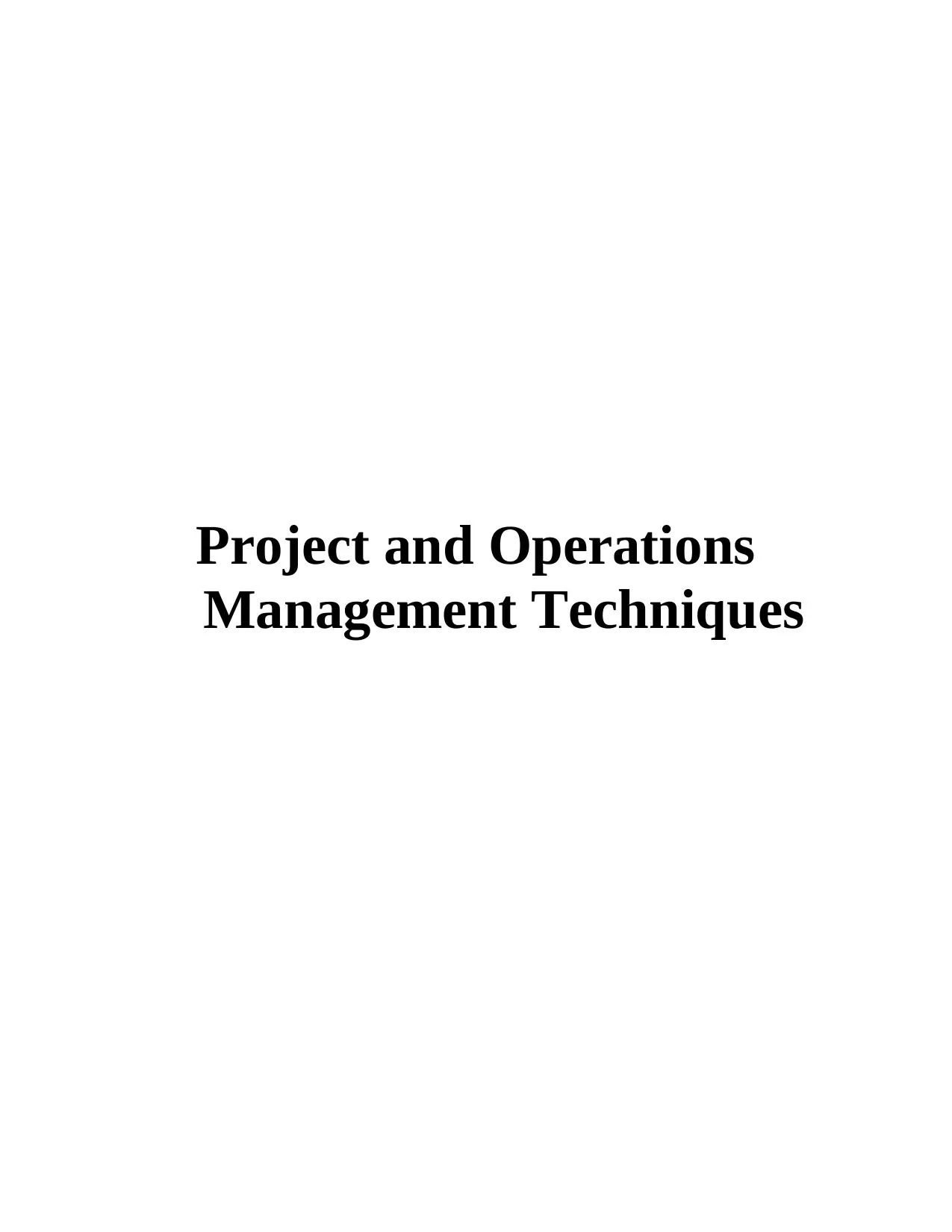
Project and Operations
Management Techniques
Management Techniques
Secure Best Marks with AI Grader
Need help grading? Try our AI Grader for instant feedback on your assignments.
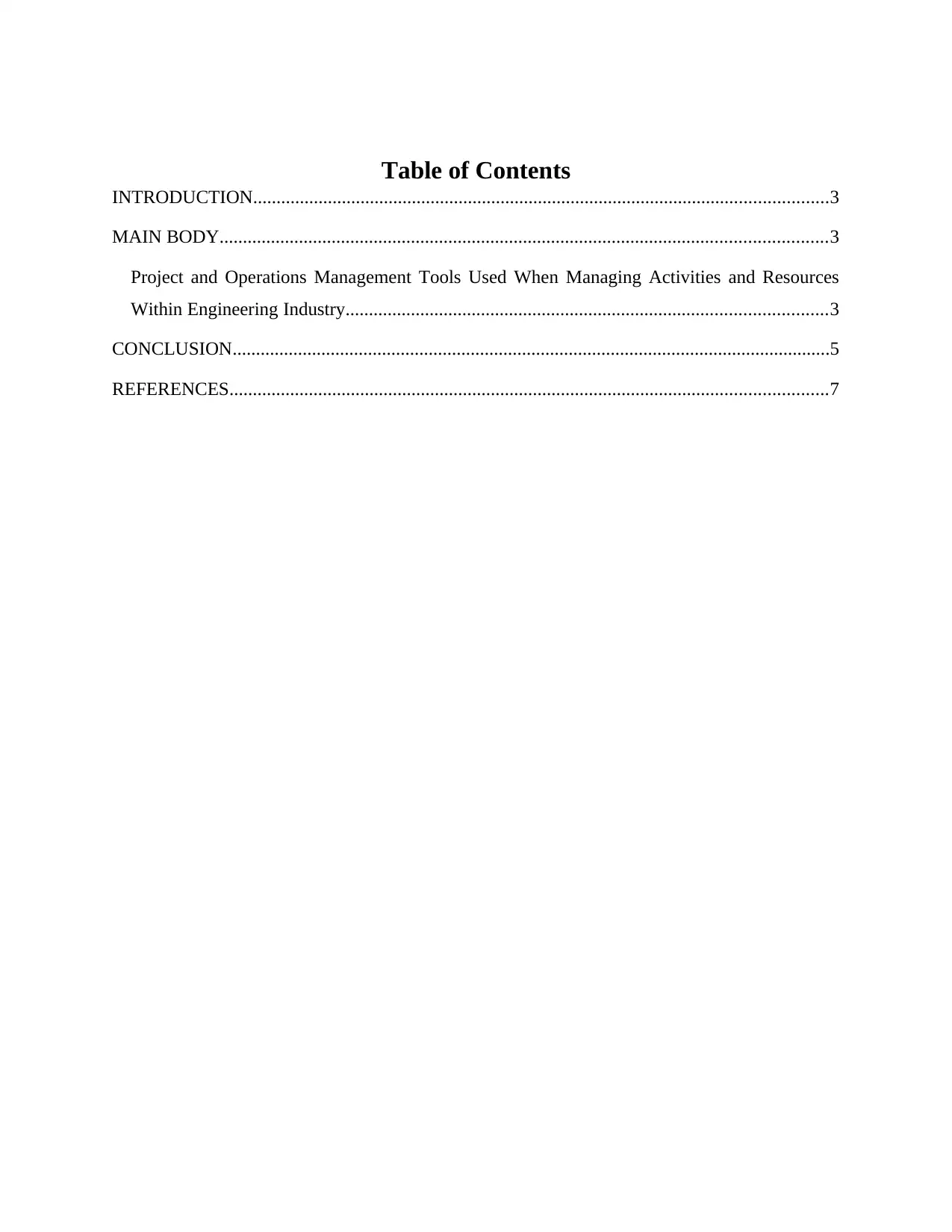
Table of Contents
INTRODUCTION...........................................................................................................................3
MAIN BODY..................................................................................................................................3
Project and Operations Management Tools Used When Managing Activities and Resources
Within Engineering Industry.......................................................................................................3
CONCLUSION................................................................................................................................5
REFERENCES................................................................................................................................7
INTRODUCTION...........................................................................................................................3
MAIN BODY..................................................................................................................................3
Project and Operations Management Tools Used When Managing Activities and Resources
Within Engineering Industry.......................................................................................................3
CONCLUSION................................................................................................................................5
REFERENCES................................................................................................................................7
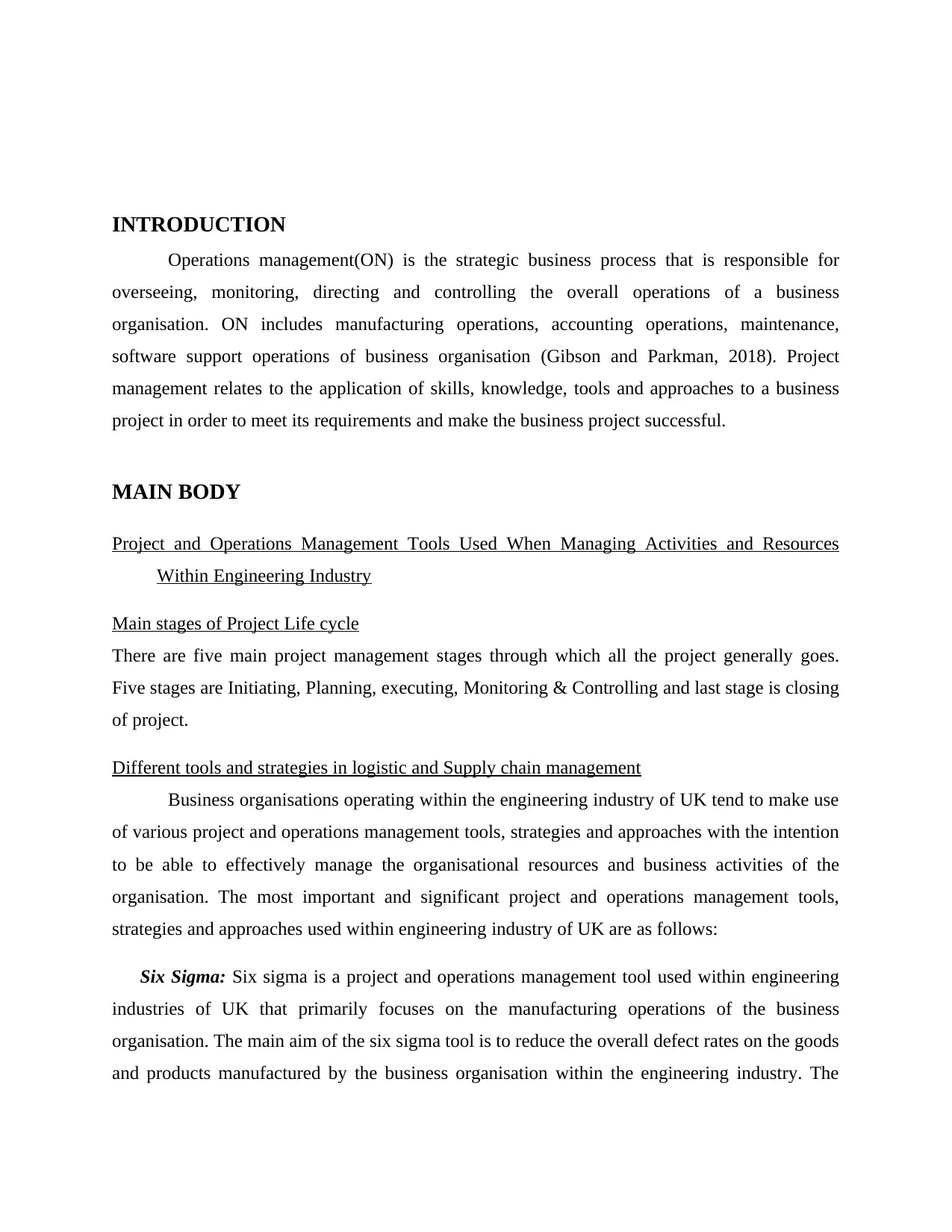
INTRODUCTION
Operations management(ON) is the strategic business process that is responsible for
overseeing, monitoring, directing and controlling the overall operations of a business
organisation. ON includes manufacturing operations, accounting operations, maintenance,
software support operations of business organisation (Gibson and Parkman, 2018). Project
management relates to the application of skills, knowledge, tools and approaches to a business
project in order to meet its requirements and make the business project successful.
MAIN BODY
Project and Operations Management Tools Used When Managing Activities and Resources
Within Engineering Industry
Main stages of Project Life cycle
There are five main project management stages through which all the project generally goes.
Five stages are Initiating, Planning, executing, Monitoring & Controlling and last stage is closing
of project.
Different tools and strategies in logistic and Supply chain management
Business organisations operating within the engineering industry of UK tend to make use
of various project and operations management tools, strategies and approaches with the intention
to be able to effectively manage the organisational resources and business activities of the
organisation. The most important and significant project and operations management tools,
strategies and approaches used within engineering industry of UK are as follows:
Six Sigma: Six sigma is a project and operations management tool used within engineering
industries of UK that primarily focuses on the manufacturing operations of the business
organisation. The main aim of the six sigma tool is to reduce the overall defect rates on the goods
and products manufactured by the business organisation within the engineering industry. The
Operations management(ON) is the strategic business process that is responsible for
overseeing, monitoring, directing and controlling the overall operations of a business
organisation. ON includes manufacturing operations, accounting operations, maintenance,
software support operations of business organisation (Gibson and Parkman, 2018). Project
management relates to the application of skills, knowledge, tools and approaches to a business
project in order to meet its requirements and make the business project successful.
MAIN BODY
Project and Operations Management Tools Used When Managing Activities and Resources
Within Engineering Industry
Main stages of Project Life cycle
There are five main project management stages through which all the project generally goes.
Five stages are Initiating, Planning, executing, Monitoring & Controlling and last stage is closing
of project.
Different tools and strategies in logistic and Supply chain management
Business organisations operating within the engineering industry of UK tend to make use
of various project and operations management tools, strategies and approaches with the intention
to be able to effectively manage the organisational resources and business activities of the
organisation. The most important and significant project and operations management tools,
strategies and approaches used within engineering industry of UK are as follows:
Six Sigma: Six sigma is a project and operations management tool used within engineering
industries of UK that primarily focuses on the manufacturing operations of the business
organisation. The main aim of the six sigma tool is to reduce the overall defect rates on the goods
and products manufactured by the business organisation within the engineering industry. The
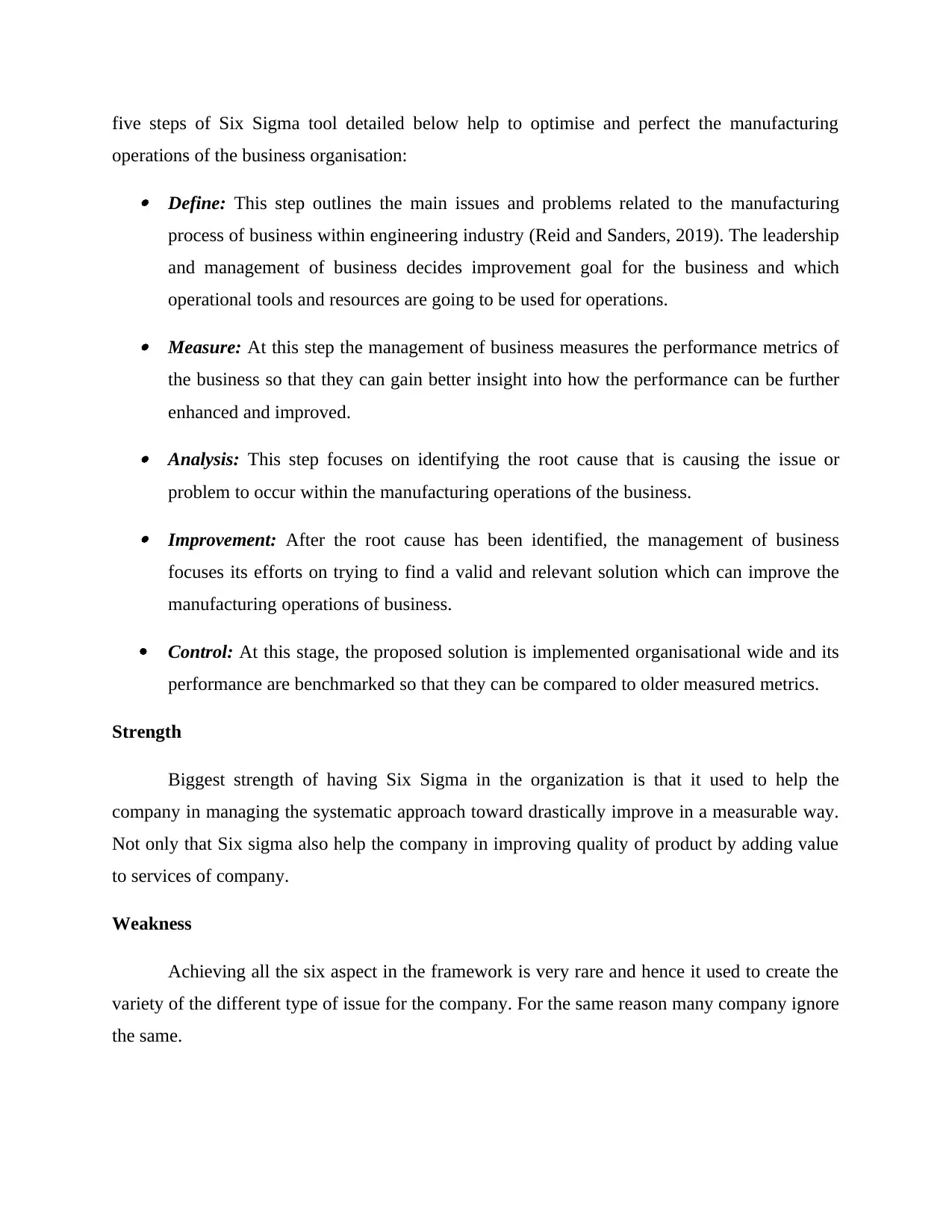
five steps of Six Sigma tool detailed below help to optimise and perfect the manufacturing
operations of the business organisation:
Define: This step outlines the main issues and problems related to the manufacturing
process of business within engineering industry (Reid and Sanders, 2019). The leadership
and management of business decides improvement goal for the business and which
operational tools and resources are going to be used for operations.
Measure: At this step the management of business measures the performance metrics of
the business so that they can gain better insight into how the performance can be further
enhanced and improved.
Analysis: This step focuses on identifying the root cause that is causing the issue or
problem to occur within the manufacturing operations of the business.
Improvement: After the root cause has been identified, the management of business
focuses its efforts on trying to find a valid and relevant solution which can improve the
manufacturing operations of business.
Control: At this stage, the proposed solution is implemented organisational wide and its
performance are benchmarked so that they can be compared to older measured metrics.
Strength
Biggest strength of having Six Sigma in the organization is that it used to help the
company in managing the systematic approach toward drastically improve in a measurable way.
Not only that Six sigma also help the company in improving quality of product by adding value
to services of company.
Weakness
Achieving all the six aspect in the framework is very rare and hence it used to create the
variety of the different type of issue for the company. For the same reason many company ignore
the same.
operations of the business organisation:
Define: This step outlines the main issues and problems related to the manufacturing
process of business within engineering industry (Reid and Sanders, 2019). The leadership
and management of business decides improvement goal for the business and which
operational tools and resources are going to be used for operations.
Measure: At this step the management of business measures the performance metrics of
the business so that they can gain better insight into how the performance can be further
enhanced and improved.
Analysis: This step focuses on identifying the root cause that is causing the issue or
problem to occur within the manufacturing operations of the business.
Improvement: After the root cause has been identified, the management of business
focuses its efforts on trying to find a valid and relevant solution which can improve the
manufacturing operations of business.
Control: At this stage, the proposed solution is implemented organisational wide and its
performance are benchmarked so that they can be compared to older measured metrics.
Strength
Biggest strength of having Six Sigma in the organization is that it used to help the
company in managing the systematic approach toward drastically improve in a measurable way.
Not only that Six sigma also help the company in improving quality of product by adding value
to services of company.
Weakness
Achieving all the six aspect in the framework is very rare and hence it used to create the
variety of the different type of issue for the company. For the same reason many company ignore
the same.
Secure Best Marks with AI Grader
Need help grading? Try our AI Grader for instant feedback on your assignments.
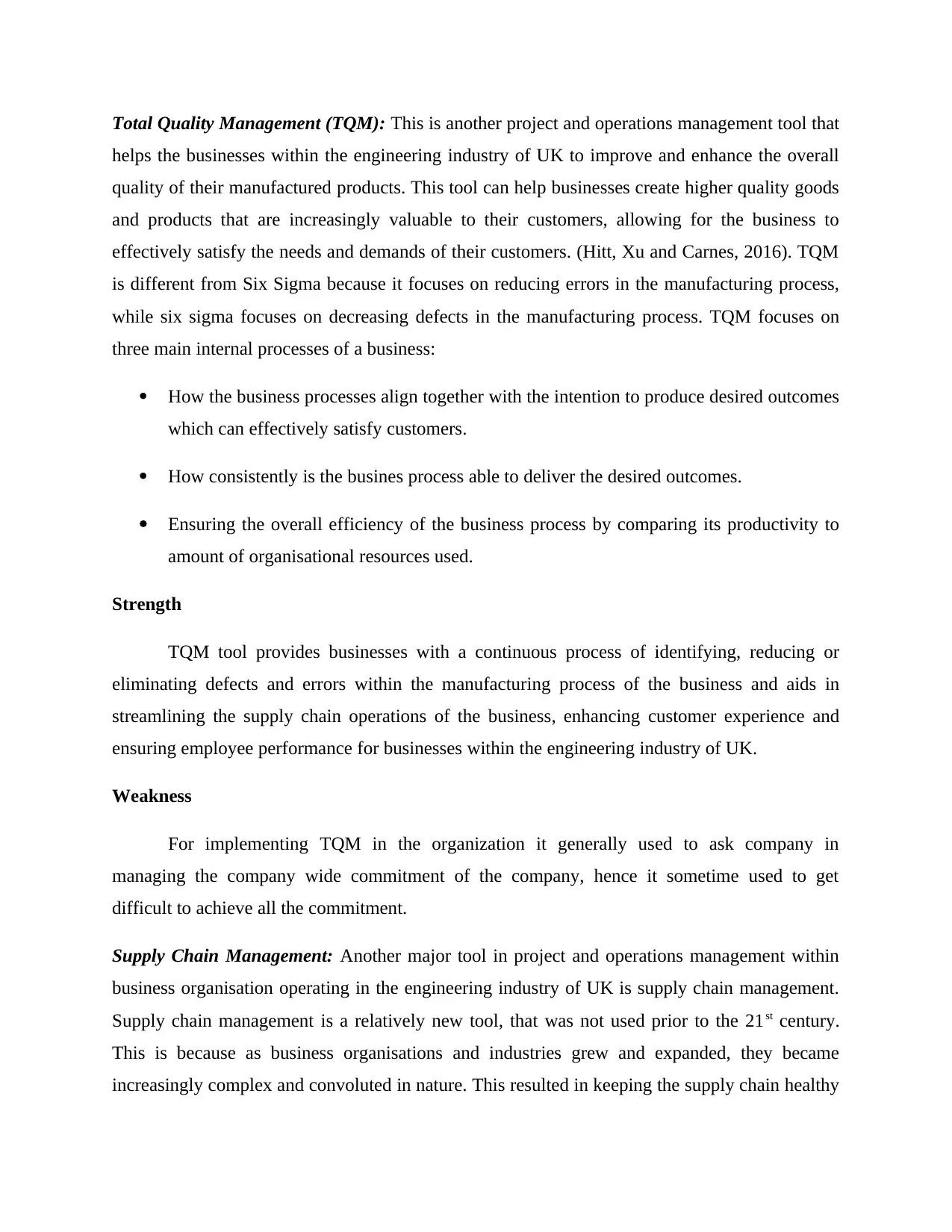
Total Quality Management (TQM): This is another project and operations management tool that
helps the businesses within the engineering industry of UK to improve and enhance the overall
quality of their manufactured products. This tool can help businesses create higher quality goods
and products that are increasingly valuable to their customers, allowing for the business to
effectively satisfy the needs and demands of their customers. (Hitt, Xu and Carnes, 2016). TQM
is different from Six Sigma because it focuses on reducing errors in the manufacturing process,
while six sigma focuses on decreasing defects in the manufacturing process. TQM focuses on
three main internal processes of a business:
How the business processes align together with the intention to produce desired outcomes
which can effectively satisfy customers.
How consistently is the busines process able to deliver the desired outcomes.
Ensuring the overall efficiency of the business process by comparing its productivity to
amount of organisational resources used.
Strength
TQM tool provides businesses with a continuous process of identifying, reducing or
eliminating defects and errors within the manufacturing process of the business and aids in
streamlining the supply chain operations of the business, enhancing customer experience and
ensuring employee performance for businesses within the engineering industry of UK.
Weakness
For implementing TQM in the organization it generally used to ask company in
managing the company wide commitment of the company, hence it sometime used to get
difficult to achieve all the commitment.
Supply Chain Management: Another major tool in project and operations management within
business organisation operating in the engineering industry of UK is supply chain management.
Supply chain management is a relatively new tool, that was not used prior to the 21st century.
This is because as business organisations and industries grew and expanded, they became
increasingly complex and convoluted in nature. This resulted in keeping the supply chain healthy
helps the businesses within the engineering industry of UK to improve and enhance the overall
quality of their manufactured products. This tool can help businesses create higher quality goods
and products that are increasingly valuable to their customers, allowing for the business to
effectively satisfy the needs and demands of their customers. (Hitt, Xu and Carnes, 2016). TQM
is different from Six Sigma because it focuses on reducing errors in the manufacturing process,
while six sigma focuses on decreasing defects in the manufacturing process. TQM focuses on
three main internal processes of a business:
How the business processes align together with the intention to produce desired outcomes
which can effectively satisfy customers.
How consistently is the busines process able to deliver the desired outcomes.
Ensuring the overall efficiency of the business process by comparing its productivity to
amount of organisational resources used.
Strength
TQM tool provides businesses with a continuous process of identifying, reducing or
eliminating defects and errors within the manufacturing process of the business and aids in
streamlining the supply chain operations of the business, enhancing customer experience and
ensuring employee performance for businesses within the engineering industry of UK.
Weakness
For implementing TQM in the organization it generally used to ask company in
managing the company wide commitment of the company, hence it sometime used to get
difficult to achieve all the commitment.
Supply Chain Management: Another major tool in project and operations management within
business organisation operating in the engineering industry of UK is supply chain management.
Supply chain management is a relatively new tool, that was not used prior to the 21st century.
This is because as business organisations and industries grew and expanded, they became
increasingly complex and convoluted in nature. This resulted in keeping the supply chain healthy
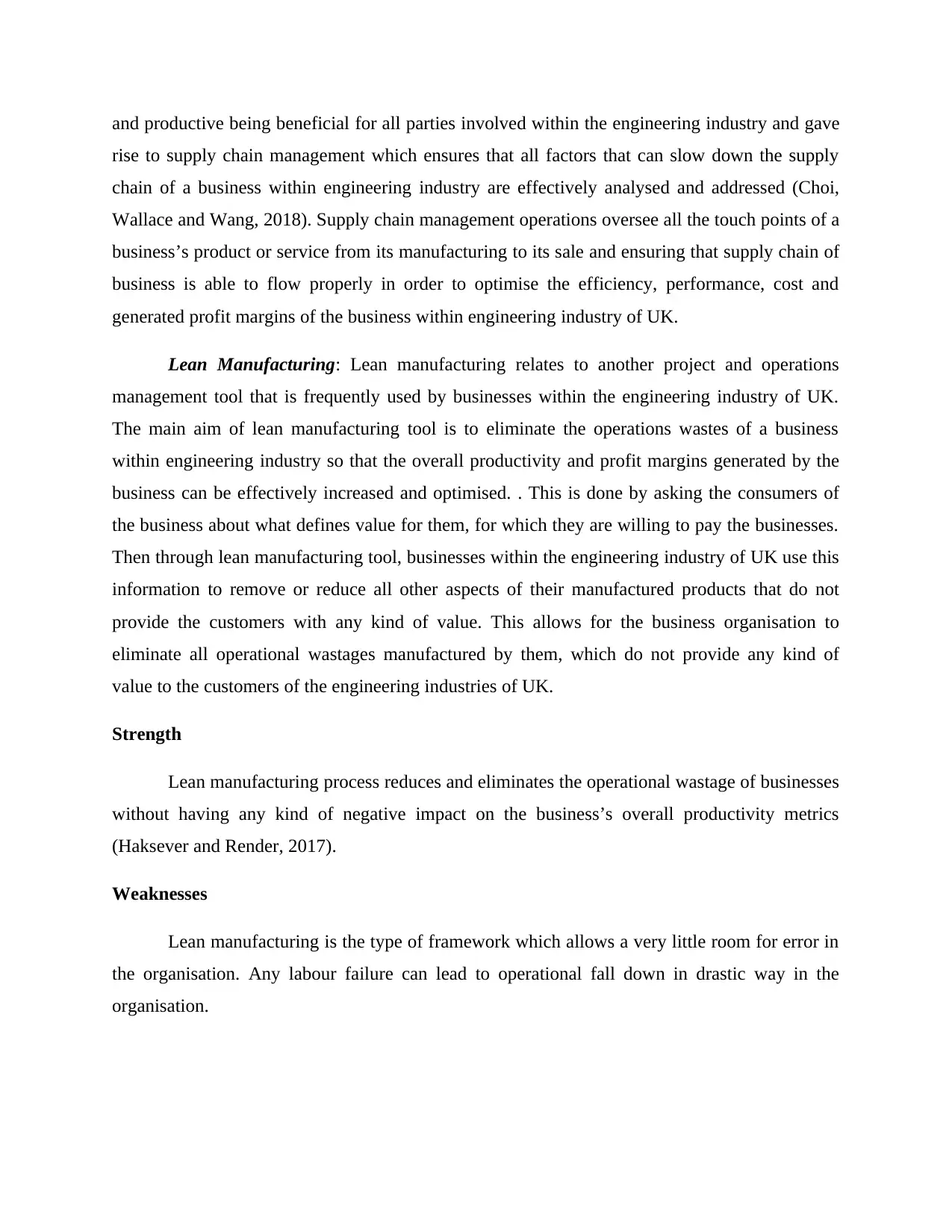
and productive being beneficial for all parties involved within the engineering industry and gave
rise to supply chain management which ensures that all factors that can slow down the supply
chain of a business within engineering industry are effectively analysed and addressed (Choi,
Wallace and Wang, 2018). Supply chain management operations oversee all the touch points of a
business’s product or service from its manufacturing to its sale and ensuring that supply chain of
business is able to flow properly in order to optimise the efficiency, performance, cost and
generated profit margins of the business within engineering industry of UK.
Lean Manufacturing: Lean manufacturing relates to another project and operations
management tool that is frequently used by businesses within the engineering industry of UK.
The main aim of lean manufacturing tool is to eliminate the operations wastes of a business
within engineering industry so that the overall productivity and profit margins generated by the
business can be effectively increased and optimised. . This is done by asking the consumers of
the business about what defines value for them, for which they are willing to pay the businesses.
Then through lean manufacturing tool, businesses within the engineering industry of UK use this
information to remove or reduce all other aspects of their manufactured products that do not
provide the customers with any kind of value. This allows for the business organisation to
eliminate all operational wastages manufactured by them, which do not provide any kind of
value to the customers of the engineering industries of UK.
Strength
Lean manufacturing process reduces and eliminates the operational wastage of businesses
without having any kind of negative impact on the business’s overall productivity metrics
(Haksever and Render, 2017).
Weaknesses
Lean manufacturing is the type of framework which allows a very little room for error in
the organisation. Any labour failure can lead to operational fall down in drastic way in the
organisation.
rise to supply chain management which ensures that all factors that can slow down the supply
chain of a business within engineering industry are effectively analysed and addressed (Choi,
Wallace and Wang, 2018). Supply chain management operations oversee all the touch points of a
business’s product or service from its manufacturing to its sale and ensuring that supply chain of
business is able to flow properly in order to optimise the efficiency, performance, cost and
generated profit margins of the business within engineering industry of UK.
Lean Manufacturing: Lean manufacturing relates to another project and operations
management tool that is frequently used by businesses within the engineering industry of UK.
The main aim of lean manufacturing tool is to eliminate the operations wastes of a business
within engineering industry so that the overall productivity and profit margins generated by the
business can be effectively increased and optimised. . This is done by asking the consumers of
the business about what defines value for them, for which they are willing to pay the businesses.
Then through lean manufacturing tool, businesses within the engineering industry of UK use this
information to remove or reduce all other aspects of their manufactured products that do not
provide the customers with any kind of value. This allows for the business organisation to
eliminate all operational wastages manufactured by them, which do not provide any kind of
value to the customers of the engineering industries of UK.
Strength
Lean manufacturing process reduces and eliminates the operational wastage of businesses
without having any kind of negative impact on the business’s overall productivity metrics
(Haksever and Render, 2017).
Weaknesses
Lean manufacturing is the type of framework which allows a very little room for error in
the organisation. Any labour failure can lead to operational fall down in drastic way in the
organisation.
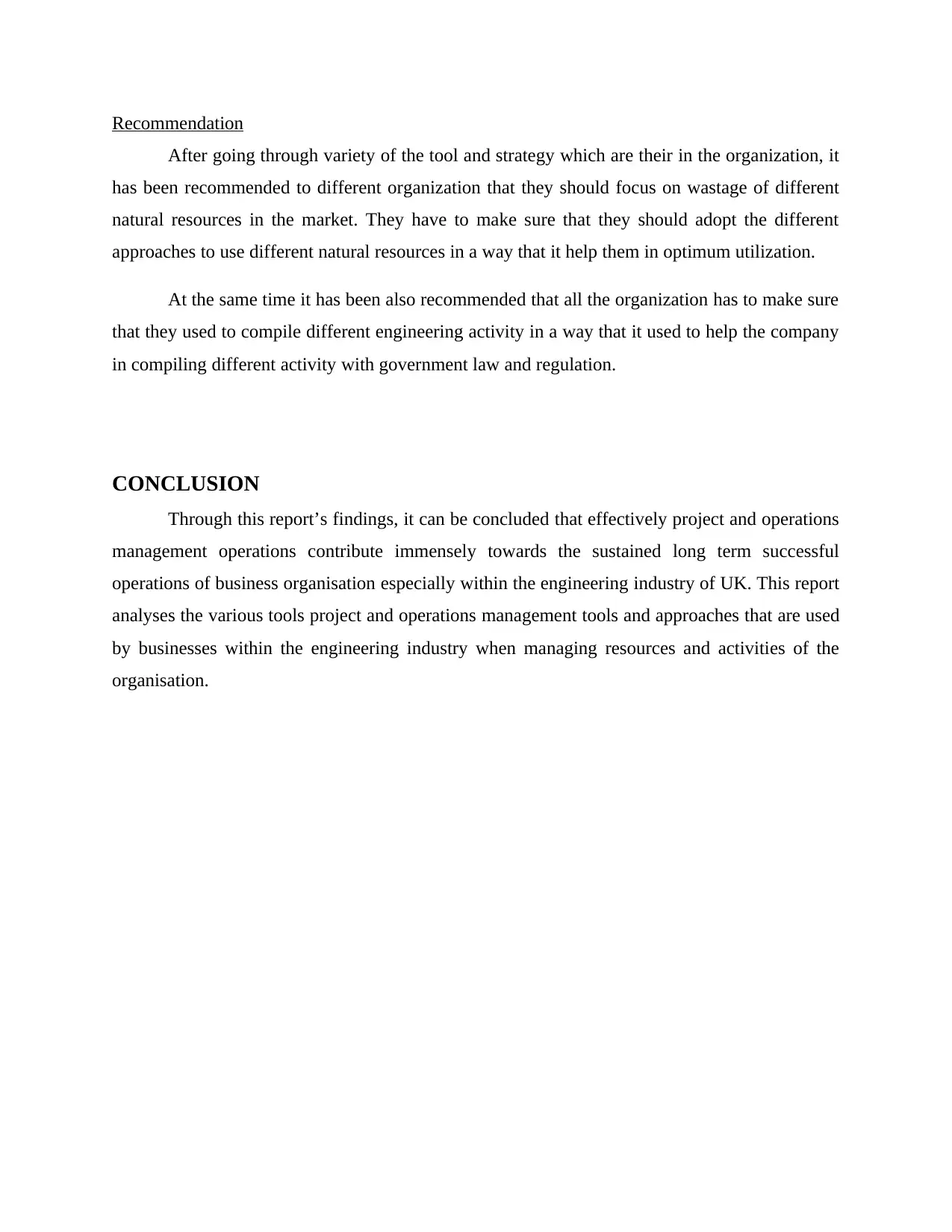
Recommendation
After going through variety of the tool and strategy which are their in the organization, it
has been recommended to different organization that they should focus on wastage of different
natural resources in the market. They have to make sure that they should adopt the different
approaches to use different natural resources in a way that it help them in optimum utilization.
At the same time it has been also recommended that all the organization has to make sure
that they used to compile different engineering activity in a way that it used to help the company
in compiling different activity with government law and regulation.
CONCLUSION
Through this report’s findings, it can be concluded that effectively project and operations
management operations contribute immensely towards the sustained long term successful
operations of business organisation especially within the engineering industry of UK. This report
analyses the various tools project and operations management tools and approaches that are used
by businesses within the engineering industry when managing resources and activities of the
organisation.
After going through variety of the tool and strategy which are their in the organization, it
has been recommended to different organization that they should focus on wastage of different
natural resources in the market. They have to make sure that they should adopt the different
approaches to use different natural resources in a way that it help them in optimum utilization.
At the same time it has been also recommended that all the organization has to make sure
that they used to compile different engineering activity in a way that it used to help the company
in compiling different activity with government law and regulation.
CONCLUSION
Through this report’s findings, it can be concluded that effectively project and operations
management operations contribute immensely towards the sustained long term successful
operations of business organisation especially within the engineering industry of UK. This report
analyses the various tools project and operations management tools and approaches that are used
by businesses within the engineering industry when managing resources and activities of the
organisation.
Paraphrase This Document
Need a fresh take? Get an instant paraphrase of this document with our AI Paraphraser
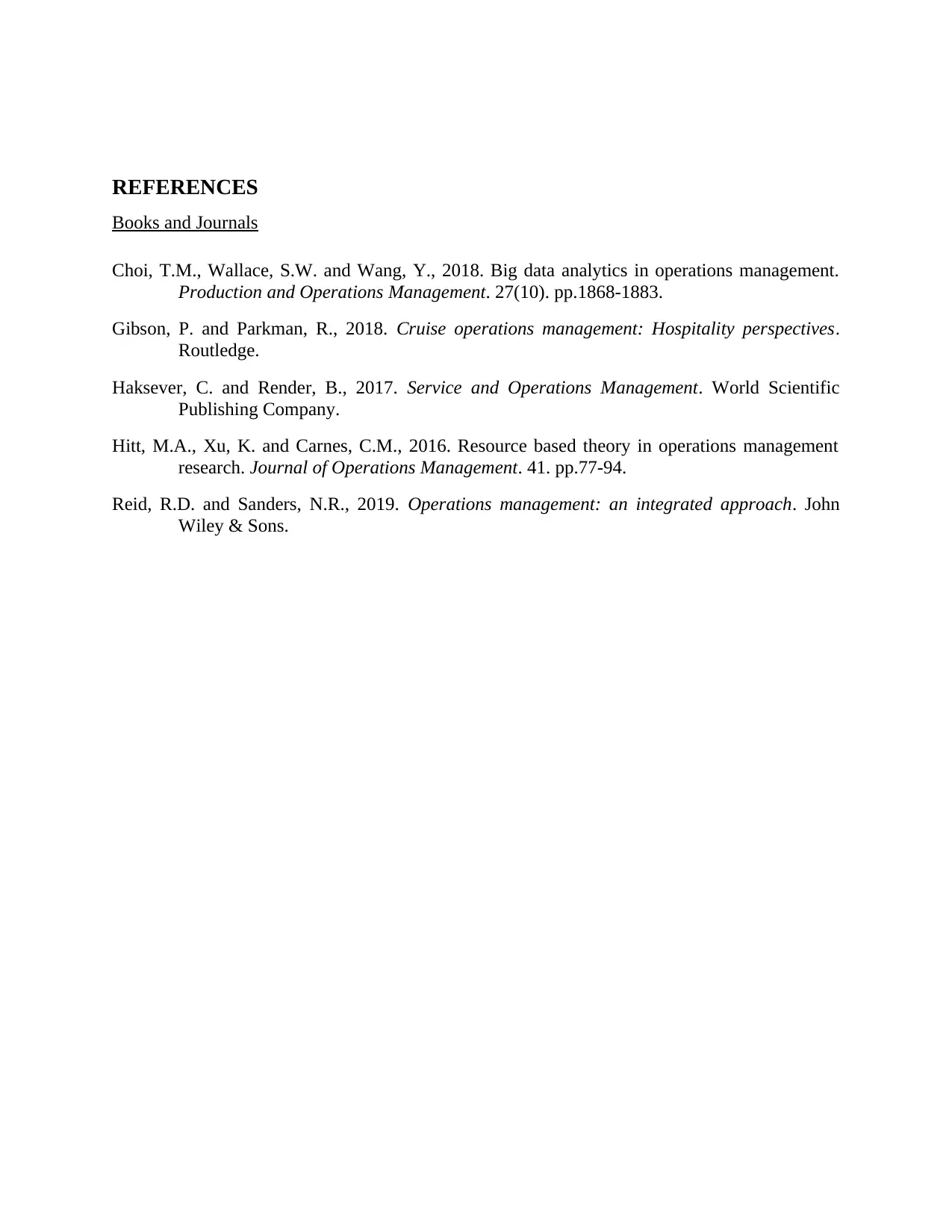
REFERENCES
Books and Journals
Choi, T.M., Wallace, S.W. and Wang, Y., 2018. Big data analytics in operations management.
Production and Operations Management. 27(10). pp.1868-1883.
Gibson, P. and Parkman, R., 2018. Cruise operations management: Hospitality perspectives.
Routledge.
Haksever, C. and Render, B., 2017. Service and Operations Management. World Scientific
Publishing Company.
Hitt, M.A., Xu, K. and Carnes, C.M., 2016. Resource based theory in operations management
research. Journal of Operations Management. 41. pp.77-94.
Reid, R.D. and Sanders, N.R., 2019. Operations management: an integrated approach. John
Wiley & Sons.
Books and Journals
Choi, T.M., Wallace, S.W. and Wang, Y., 2018. Big data analytics in operations management.
Production and Operations Management. 27(10). pp.1868-1883.
Gibson, P. and Parkman, R., 2018. Cruise operations management: Hospitality perspectives.
Routledge.
Haksever, C. and Render, B., 2017. Service and Operations Management. World Scientific
Publishing Company.
Hitt, M.A., Xu, K. and Carnes, C.M., 2016. Resource based theory in operations management
research. Journal of Operations Management. 41. pp.77-94.
Reid, R.D. and Sanders, N.R., 2019. Operations management: an integrated approach. John
Wiley & Sons.
1 out of 8
Related Documents
Your All-in-One AI-Powered Toolkit for Academic Success.
+13062052269
info@desklib.com
Available 24*7 on WhatsApp / Email
![[object Object]](/_next/static/media/star-bottom.7253800d.svg)
Unlock your academic potential
© 2024 | Zucol Services PVT LTD | All rights reserved.




